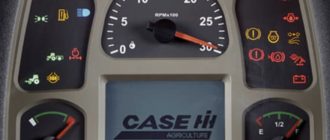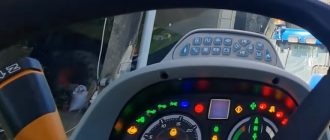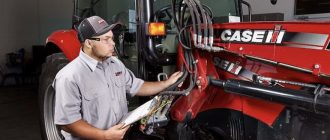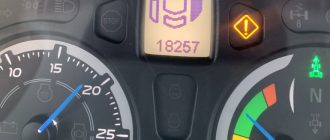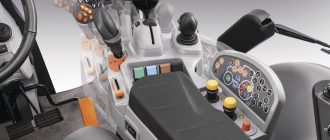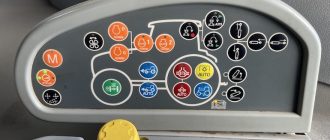Modern tractors have transformed into intricate systems powered by multifunction controllers. These controllers are the brains behind the brawn, orchestrating everything from engine performance to hydraulic operations. Yet, like all advanced systems, they can encounter hiccups, and that’s where Diagnostic Trouble Codes (DTCs) step in.
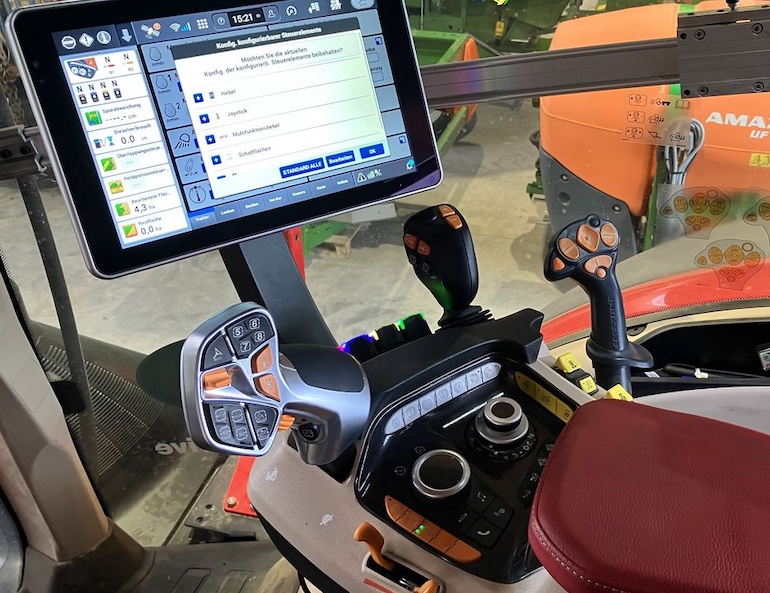
Diagnostic Trouble Codes are the tractor’s way of communicating with its mechanic. They are alphanumeric messages that provide vital clues about what might be ailing the tractor’s multifunction controller. Whether it’s an electrical glitch or a sensor hiccup, DTCs are the keys to unlocking these complex systems.
New Holland and Case IH are stalwarts of agricultural innovation, consistently pushing the envelope to redefine modern farming. Their tractors, equipped with multifunction controllers, have become the backbone of contemporary agriculture. However, even the most sophisticated systems can run into issues, and this is where DTCs become invaluable.
Our comprehensive list of New Holland and Case IH Tractor Multifunction Controller Error Codes (DTCs) is every mechanic’s trusted companion. It’s the resource that helps decipher the messages these tractors convey about the health of their multifunction controller systems.
New Holland & Case IH Tractor Multifunction Controller Errors
Here is the table with the error / fault code numbers and descriptions for the New Holland & Case IH Tractor Multifunction Controller:
TMF Controller Error / Fault Codes from 3 to 107
| Error Code Number | TMF Controller Error Description |
|---|---|
| TMF 3 | Hitch Lift Solenoid High voltage driver shorted to 12 volts. |
| TMF 4 | Hitch lift solenoid is faulty or shorted to ground. |
| TMF 5 | Lower hitch solenoid shorted to 12 volts. |
| TMF 6 | Hitch Lower Solenoid Upper Solenoid Driver Circuit shorted to 12V. |
| TMF 7 | Hitch Raise/Lower Solenoids Open or shorted to ground. |
| TMF 11 | Lost communication with data bus and ALL other controllers |
| TMF 12 | Lost communication with armrest controller |
| TMF 14 | 5 V sensor Supply voltage too high |
| TMF 15 | 5 V Sensor Supply voltage too low |
| TMF 17 | Malfunction of the hitch position control potentiometer in the armrest controller |
| TMF 18 | Hitch Drive shaft position The potentiometer is outside the normal operating range. |
| TMF 19 | hitch high limit potentiometer is faulty in the armrest controller. |
| TMF 21 | Malfunction of the hitch load control potentiometer in the armrest controller |
| TMF 22 | One draw pin sensor failed when configured for one draw pin sensor. |
| TMF 23 | Malfunction of two tractor pin sensors when configured for two tractor pins. |
| TMF 24 | Loss of communication with the instrument controller |
| TMF 25 | Faulty raise/lower switch in the armrest controller |
| TMF 26 | Fender UP and DOWN switch failure or both switches pressed at the same time |
| TMF 28 | hitch travel potentiometer defective in armrest controller. |
| TMF 29 | Defective hitch fall rate potentiometer in the armrest controller. |
| TMF 30 | The voltage at the right linkage contact is outside the normal operating range. |
| TMF 31 | Left linkage pin voltage is out of normal operating range. |
| TMF 32 | Ground speed signal error in instrument controller |
| TMF 33 | Malfunction of the hitch slip setting switch in the armrest controller |
| TMF 34 | Faulty hitch slip select switch in armrest controller |
| TMF 35 | slip sensor (radar or wheel speed) not working in gauge controller |
| TMF 37 | ARU reports that the EDC transport lock is faulty or unavailable. |
| TMF 41 | Traction pins detected but armrest controller indicated tractor without traction control. |
| TMF 42 | Engine speed must be set above 1600 rpm during bottom valve calibration. |
| TMF 43 | No traction pins detected, but the armrest controller indicated a tractor with traction control. |
| TMF 44 | Hitch calibration aborted due to tractor movement. |
| TMF 45 | Attempt to calibrate hitch with engine off or no engine speed signal. |
| TMF 47 | Lift valve calibration value too high. (valve problem) |
| TMF 48 | Lift valve calibration value too low. (valve problem) |
| TMF 50 | Hitch position at top of travel out of specification during calibration |
| TMF 51 | Bottom valve calibration value too high. (valve problem) |
| TMF 52 | Bottom valve calibration value too low. (valve problem) |
| TMF 53 | Hitch calibration time expired. |
| TMF 54 | Lower stroke hitch position out of specification during calibration |
| TMF 55 | Top-down hitch position range out of specification during calibration |
| TMF 56 | The ratio of hitch position range to command position range is out of specification during calibration. |
| TMF 57 | Right link pin voltage out of specification for no-load condition during calibration. |
| TMF 58 | Left pin voltage out of specification for off-load condition during calibration. |
| TMF 59 | Voltages on both project outputs are out of specification for off-load state during calibration. |
| TMF 60 | Traction pin connected left and right for single pin installation during calibration |
| TMF 61 | The hitch calibration procedure needs to be completed. |
| TMF 62 | Lost Communication with Performance Monitor Function |
| TMF 63 | The 8 V reference of the controller is too high (above 8.8 V). |
| TMF 64 | The 8 V reference of the controller is too low (below 7.2 V). |
| TMF 65 | Battery voltage too low |
| TMF 66 | Battery voltage too low |
| TMF 80 | Faulty MFD in software. |
| TMF 81 | Solenoid MFD defective Open or short circuit |
| TMF 82 | Differential lock solenoid defective Open or short circuit |
| TMF 83 | Stop lamp relay solenoid defective, open or short circuit |
| TMF 86 | Wheel slip signal error in instrument controller |
| TMF 87 | Ground speed signal error in instrument controller |
| TMF 88 | The differential lock switch is faulty in the armrest controller. |
| TMF 89 | Malfunction of the differential lock switch in the armrest controller |
| TMF 90 | The differential lock switch is defective in the armrest controller. |
| TMF 92 | Malfunction of the MFD switch in the armrest controller. |
| TMF 93 | Malfunction of the MFD switch in the armrest controller. |
| TMF 94 | Differential lock error in software. |
| TMF 95 | Steering angle sensor above expected operating range. |
| TMF 96 | Steering angle sensor below expected operating range. |
| TMF 98 | Battery voltage too low. |
| TMF 99 | Battery voltage too low. |
| TMF 106 | The 5th auxiliary valve (extension) remote control switch is faulty in the armrest controller. |
| TMF 107 | The 5th auxiliary valve (retract) remote control switch is faulty in the armrest controller. |
TMF Controller Error / Fault Codes from 108 to 180
| Error Code Number | TMF Controller Error Description |
|---|---|
| TMF 108 | Malfunction of the LEVER potentiometer of the Aux 1 remote valve in the armrest controller |
| TMF 109 | Auxiliary 2nd remote valve LEVER potentiometer in armrest controller defective. |
| TMF 110 | Aux 3rd remote valve LEVER potentiometer defective in armrest controller |
| TMF 111 | Auxiliary 4th remote valve LEVER potentiometer defective in armrest controller |
| TMF 112 | Faulty FLOW potentiometer auxiliary 1st remote valve in the armrest controller |
| TMF 113 | Faulty FLOW potentiometer 2nd auxiliary remote valve in the armrest controller |
| TMF 114 | FLOW potentiometer malfunction of the 3rd auxiliary remote valve in the armrest controller |
| TMF 115 | Faulty FLOW potentiometer of the 4th remote control auxiliary valve in the armrest controller |
| TMF 116 | Malfunction of the FLOW potentiometer of the auxiliary 5th remote valve in the armrest controller |
| TMF 120 | Top link electro-hydraulic remote switch stuck on. |
| TMF 123 | Aux 1st Lower Coil solenoid shorted to 12 volts. |
| TMF 124 | Aux 1st Lower solenoid is defective, open or shorted. |
| TMF 125 | Aux 1st Raise Coil solenoid shorted to 12 volts. |
| TMF 126 | Aux 1st Lift solenoid is defective, open or shorted. |
| TMF 127 | Aux 2nd Lower Coil solenoid is shorted to 12 volts. |
| TMF 128 | Auxiliary 2nd lower solenoid is defective, open or short circuit. |
| TMF 129 | Aux 2nd Raise Coil solenoid shorted to 12 volts. |
| TMF 130 | Aux 2nd Lift solenoid is defective, open or shorted. |
| TMF 131 | 3rd lower coil auxiliary solenoid shorted to 12 volts. |
| TMF 132 | Aux 3rd lower solenoid is defective, open or shorted. |
| TMF 133 | Aux 3rd Raise Coil Solenoid is shorted to 12 volts. |
| TMF 134 | 3rd lift auxiliary solenoid is defective, open or short circuit. |
| TMF 135 | Aux 4th lower coil solenoid shorted to 12 volts. |
| TMF 136 | Auxiliary 4th lower solenoid is defective, open or short circuit. |
| TMF 137 | Aux 4th Raise Coil solenoid is shorted to 12 volts. |
| TMF 138 | Aux 4th Lift solenoid is defective, open or shorted. |
| TMF 139 | Aux 5th Lower Coil solenoid is shorted to 12 volts. |
| TMF 141 | Aux 5th Raise Coil solenoid is shorted to 12 volts. |
| TMF 142 | Aux 5th Lift solenoid is defective, open or shorted. |
| TMF 147 | Unit #1 feedback out of range High. |
| TMF 148 | Unit #1 feedback out of range Low. |
| TMF 149 | Unit #2 feedback out of range High. |
| TMF 150 | Unit #2 feedback out of range Low. |
| TMF 151 | Loss of communication with the transfer controller. |
| TMF 152 | Electro Hydraulic Remote Top link switch voltage short circuit. |
| TMF 153 | Top link electro-hydraulic remote switch Incorrect data. |
| TMF 154 | PTO switch interlock – cabin switch and wing are switched on at the same time. |
| TMF 155 | Auto PTO switch data error in armrest controller. |
| TMF 156 | Auto PTO switch is stuck on in the armrest controller. |
| TMF 157 | PTO wing remote switch short circuit. |
| TMF 158 | Open circuit of the remote PTO switch on the wing |
| TMF 159 | The remote PTO switch on the wing is jammed. |
| TMF 160 | PTO clutch slips too much |
| TMF 162 | Engine stalled with PTO running. |
| TMF 163 | PTO rotation is detected when the PTO is disengaged. |
| TMF 164 | PTO shaft speed is not detected within 3.6 seconds after switching on. |
| TMF 165 | PTO rotation is detected with the engine off. |
| TMF 166 | The power take-off driver is enabled, but no current is measured. |
| TMF 167 | Determines the current when the PTO drive is off. |
| TMF 168 | PTO ON/OFF switch defective in armrest controller |
| TMF 169 | PTO ON/OFF switch defective in armrest controller |
| TMF 170 | Malfunction of the PTO ON/OFF switch in the armrest controller |
| TMF 171 | PTO software error detected. |
| TMF 172 | PTO solenoid circuit is faulty, shorted to 12V when PTO is off. |
| TMF 173 | PTO solenoid circuit is not shorted to ground when PTO is off. |
| TMF 174 | Current flowing through the PTO sensor resistor when the high voltage side is off. |
| TMF 175 | PTO clutch did not reach lock speed within 6 seconds after being engaged |
| TMF 178 | Replaced PTO speed sensor. |
| TMF 179 | PTO does not receive frequency from shaft size sensor on 2 speed PTO. |
| TMF 180 | The PTO receives signals from a shaft size sensor in a single speed PTO configuration. |
Being a tractor mechanic is more than a profession; it’s a crucial role in sustaining agriculture. Your understanding of these machines ensures that farmers can optimize their operations, minimize downtime, and ultimately feed the world. Each DTC you decode is a step toward a more efficient and productive farming future.
Whether you’re a seasoned mechanic or just beginning your journey in this field, our guide to Tractor Multifunction Controller DTCs for New Holland and Case IH tractors is your reliable companion. It’s your portal into the heart of these remarkable machines, where every code tells a story, and every repair ensures that the gears of agriculture keep turning.
Can I Clear Tractor Multifunction Controller Error Codes Myself?
Clearing multifunction controller error codes on Case IH and New Holland tractors should be approached with caution. Error codes are important indicators of potential issues within the tractor’s systems, and clearing them without addressing the root cause may lead to persistent problems.
Here are some considerations before attempting to clear multifunction controller error codes:
- Refer to the Tractor Manual: Consult the tractor’s service manual for information about multifunction controller error codes, their meanings, and any recommended troubleshooting steps. The manual will provide specific guidance related to your tractor model.
- Address Underlying Issues: Before attempting to clear error codes, identify and address any underlying issues causing the codes. Clearing codes without resolving the problem may lead to ongoing malfunctions.
- Use Diagnostic Tractor Tools: Some tractors may require specialized diagnostic tools to clear error codes. If you have access to such tools, follow the manufacturer’s instructions for code clearing procedures.
- Disconnect. Tractor Battery: Disconnecting the tractor’s battery for a short period may reset the electronic control systems and clear error codes. However, this method may not work for all models, and it’s essential to check the manual.
- Seek Professional Assistance: If you are unsure about how to clear multifunction controller error codes or if you are unable to resolve the underlying issue, it’s advisable to seek assistance from a certified Case IH or New Holland mechanic or an authorized service center. They have the expertise to diagnose and address problems properly.
Clearing error codes without addressing the root cause may lead to ongoing issues. If you’re not comfortable or familiar with the diagnostic procedures, it’s best to involve professionals who can ensure proper troubleshooting and resolution. Always prioritize safety and follow manufacturer guidelines when working on your tractor.
How Can I Prevent Tractor Multifunction Controller Error Codes?
Preventing multifunction controller error codes on tractors, including those from Case IH and New Holland, involves a combination of regular maintenance, proper operation, and prompt troubleshooting. Here are some tips to help prevent multifunction controller error codes:
- Regular Maintenance: Follow the manufacturer’s recommended maintenance schedule outlined in the tractor’s service manual. Regularly check and replace fluids, filters, and worn-out components to ensure optimal performance.
- Operate within Specifications: Operate the tractor within the specified operating parameters outlined in the user manual. Avoid exceeding load capacities, operating at extreme temperatures, or pushing the tractor beyond its design limits.
- Calibrate Sensors: If your tractor is equipped with sensors, ensure they are calibrated according to the manufacturer’s guidelines. Accurate sensor readings are crucial for proper system function.
- Monitor Warning Lights: Pay attention to warning lights or indicators on the tractor’s dashboard. If any warning lights illuminate, address the issue promptly rather than continuing to operate the tractor with potential problems.
- Avoid Overloading: Do not overload the tractor or its implements. Excessive loads can strain the multifunction controller and other components, leading to errors.
- Protect from Environmental Factors: Shield the tractor from extreme weather conditions, especially when not in use. Moisture, excessive heat, and other environmental factors can contribute to electrical issues.
- Proper Shutdown Procedures: Follow proper shutdown procedures outlined in the manual. Avoid abrupt stops or shutting down the tractor without allowing it to cool down if necessary.
- Keep Software Updated: If your tractor’s multifunction controller relies on software, keep it updated to the latest version provided by the manufacturer. Software updates may include improvements and bug fixes.
- Professional Inspections: Schedule regular inspections by certified technicians. Professionals can identify and address potential issues before they lead to error codes.
- Operator Training: Ensure that tractor operators are trained on proper usage, maintenance, and troubleshooting procedures. Knowledgeable operators are more likely to detect and prevent issues.
- Use Quality Fuels and Lubricants: Use recommended fuels and lubricants to maintain the tractor’s engine and other components. Poor-quality fuels or lubricants can contribute to performance issues.
By following these preventive measures, you can minimize the likelihood of multifunction controller error codes on your tractor. Regular maintenance, proper operation, and prompt attention to warning signs contribute to the overall reliability and longevity of the tractor’s electronic systems.
DTC Fault Code Lists of New Holland & Case IH Tractors:
- Armrest Errors
- ATC Error Codes
- Auxiliary Remote Valve Errors
- DCU Errors
- Engine Error Codes
- Front PTO Error Codes
- Hitch Error Codes
- Instrument Control Unit Errors
- INST Error Codes
- MFD/Diff List of Errors
- Rear PTO Error Codes
- Suspension Errors
- Transmission Error Codes
- FAQ for CNH Industrial DTCs
